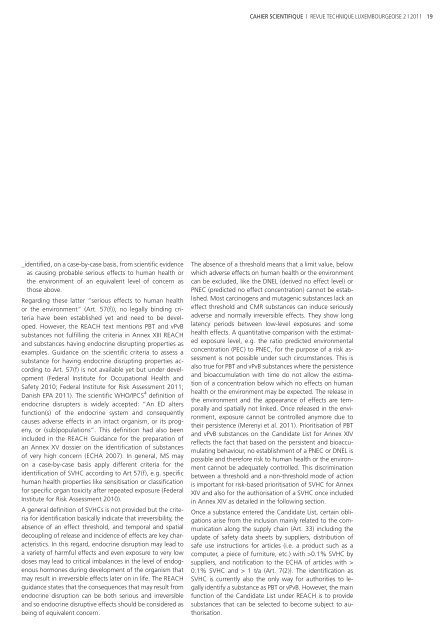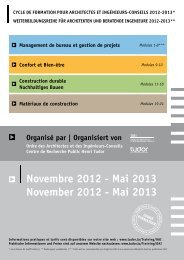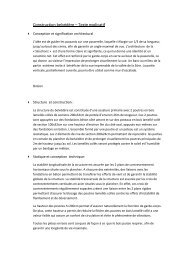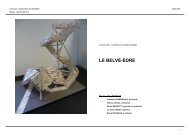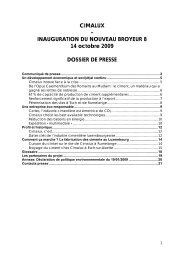Cahier Scientifique 02 | 2011 (PDF) - Revue Technique ...
Cahier Scientifique 02 | 2011 (PDF) - Revue Technique ...
Cahier Scientifique 02 | 2011 (PDF) - Revue Technique ...
Create successful ePaper yourself
Turn your PDF publications into a flip-book with our unique Google optimized e-Paper software.
CAHIER SCIENTIFIQUE | REVUE TECHNIQUE LUXEMBOURGEOISE 2 | <strong>2011</strong><br />
19<br />
_identified, on a case-by-case basis, from scientific evidence<br />
as causing probable serious effects to human health or<br />
the environment of an equivalent level of concern as<br />
those above.<br />
Regarding these latter “serious effects to human health<br />
or the environment” (Art. 57(f)), no legally binding criteria<br />
have been established yet and need to be developed.<br />
However, the REACH text mentions PBT and vPvB<br />
substances not fulfilling the criteria in Annex XIII REACH<br />
and substances having endocrine disrupting properties as<br />
examples. Guidance on the scientific criteria to assess a<br />
substance for having endocrine disrupting properties according<br />
to Art. 57(f) is not available yet but under development<br />
(Federal Institute for Occupational Health and<br />
Safety 2010; Federal Institute for Risk Assessment <strong>2011</strong>;<br />
Danish EPA <strong>2011</strong>). The scientific WHO/IPCS 4 definition of<br />
endocrine disrupters is widely accepted: “An ED alters<br />
function(s) of the endocrine system and consequently<br />
causes adverse effects in an intact organism, or its progeny,<br />
or (sub)populations”. This definition had also been<br />
included in the REACH Guidance for the preparation of<br />
an Annex XV dossier on the identification of substances<br />
of very high concern (ECHA 2007). In general, MS may<br />
on a case-by-case basis apply different criteria for the<br />
identification of SVHC according to Art 57(f), e.g. specific<br />
human health properties like sensitisation or classification<br />
for specific organ toxicity after repeated exposure (Federal<br />
Institute for Risk Assessment 2010).<br />
A general definition of SVHCs is not provided but the criteria<br />
for identification basically indicate that irreversibility, the<br />
absence of an effect threshold, and temporal and spatial<br />
decoupling of release and incidence of effects are key characteristics.<br />
In this regard, endocrine disruption may lead to<br />
a variety of harmful effects and even exposure to very low<br />
doses may lead to critical imbalances in the level of endogenous<br />
hormones during development of the organism that<br />
may result in irreversible effects later on in life. The REACH<br />
guidance states that the consequences that may result from<br />
endocrine disruption can be both serious and irreversible<br />
and so endocrine disruptive effects should be considered as<br />
being of equivalent concern.<br />
The absence of a threshold means that a limit value, below<br />
which adverse effects on human health or the environment<br />
can be excluded, like the DNEL (derived no effect level) or<br />
PNEC (predicted no effect concentration) cannot be established.<br />
Most carcinogens and mutagenic substances lack an<br />
effect threshold and CMR substances can induce seriously<br />
adverse and normally irreversible effects. They show long<br />
latency periods between low-level exposures and some<br />
health effects. A quantitative comparison with the estimated<br />
exposure level, e.g. the ratio predicted environmental<br />
concentration (PEC) to PNEC, for the purpose of a risk assessment<br />
is not possible under such circumstances. This is<br />
also true for PBT and vPvB substances where the persistence<br />
and bioaccumulation with time do not allow the estimation<br />
of a concentration below which no effects on human<br />
health or the environment may be expected. The release in<br />
the environment and the appearance of effects are temporally<br />
and spatially not linked. Once released in the environment,<br />
exposure cannot be controlled anymore due to<br />
their persistence (Merenyi et al. <strong>2011</strong>). Prioritisation of PBT<br />
and vPvB substances on the Candidate List for Annex XIV<br />
reflects the fact that based on the persistent and bioaccumulating<br />
behaviour, no establishment of a PNEC or DNEL is<br />
possible and therefore risk to human health or the environment<br />
cannot be adequately controlled. This discrimination<br />
between a threshold and a non-threshold mode of action<br />
is important for risk-based prioritisation of SVHC for Annex<br />
XIV and also for the authorisation of a SVHC once included<br />
in Annex XIV as detailed in the following section.<br />
Once a substance entered the Candidate List, certain obligations<br />
arise from the inclusion mainly related to the communication<br />
along the supply chain (Art. 33) including the<br />
update of safety data sheets by suppliers, distribution of<br />
safe use instructions for articles (i.e. a product such as a<br />
computer, a piece of furniture, etc.) with >0.1% SVHC by<br />
suppliers, and notification to the ECHA of articles with ><br />
0.1% SVHC and > 1 t/a (Art. 7(2)). The identification as<br />
SVHC is currently also the only way for authorities to legally<br />
identify a substance as PBT or vPvB. However, the main<br />
function of the Candidate List under REACH is to provide<br />
substances that can be selected to become subject to authorisation.


